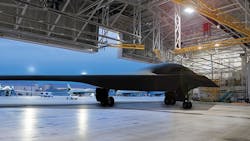B-21 designers to demonstrate advanced software and autonomy on aircraft's flight-ready avionics hardware
WASHINGTON – The Northrop Grumman B-21 is at least 18 months from a first flight milestone, but the stealth bomber’s flight-ready hardware already is participating in demonstrations of an advanced software coding process, the head of the U.S. Air Force’s acquisition arm says. Aviation Week reports. Continue reading original article
The Military & Aerospace Electronics take:
23 June 2020 -- In late 2019, the Air Force ran software code inside virtual Kubernetes containers on a Lockheed Martin F-16 in-flight, demonstrating that a process often used to run advanced autonomy in ground-based computers can work on a sophisticated, flying aircraft.
A similar demonstration has been performed on the ground with B-21 systems, says Will Roper, assistant secretary of the Air Force for acquisition, technology and logistics.
The Air Force wants to increase the pace of software updates dramatically on combat aircraft. Traditional military software development releases complex code updates in biannual blocks. By shifting to an agile, DevSecOps-style development process, the Air Force is seeking to accelerate new software code release to a matter of weeks or months.
John Keller, chief editor
Military & Aerospace Electronics
